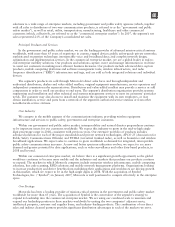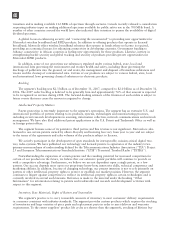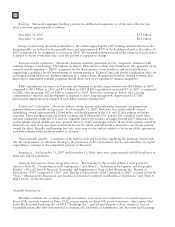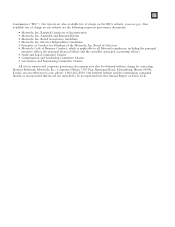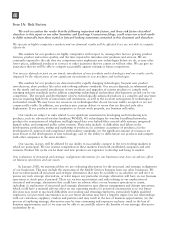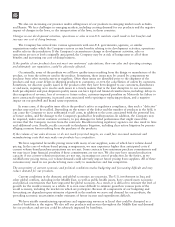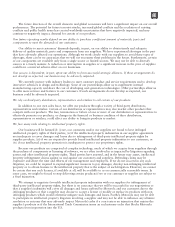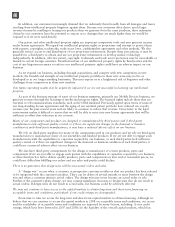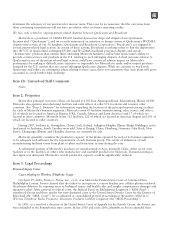Motorola 2007 Annual Report Download - page 28
Download and view the complete annual report
Please find page 28 of the 2007 Motorola annual report below. You can navigate through the pages in the report by either clicking on the pages listed below, or by using the keyword search tool below to find specific information within the annual report.
We also are increasing our presence and/or selling more of our products in emerging markets such as India
and Russia. We face challenges in emerging markets, including creating demand for our products and the negative
impact of changes in the laws, or the interpretation of the laws, in those countries.
Changes in our development activities, operations or sales in non-U.S. markets could result in lost benefits and
increase our cost of doing business.
The Company has entered into various agreements with non-U.S. governments, agencies, or similar
organizations under which the Company receives certain benefits relating to its development activities, operations
and/or sales in the jurisdiction. If the Company’s circumstances change or development activities, sales or
operations are not at levels originally anticipated, the Company may be at risk of losing some or all of these
benefits and increasing our cost of doing business.
If the quality of our products does not meet our customers’ expectations, then our sales and operating earnings,
and ultimately our reputation, could be adversely affected.
Occasionally, some of the products we sell have quality issues resulting from the design or manufacture of the
product, or from the software used in the product. Sometimes, these issues may be caused by components we
purchase from other manufacturers or suppliers. Often these issues are identified prior to the shipment of the
products and may cause delays in shipping products to customers, or even the cancellation of orders by customers.
Sometimes, we discover quality issues in the products after they have been shipped to our customers, distributors
or end-users, requiring us to resolve such issues in a timely manner that is the least disruptive to our customers.
Such pre-shipment and post-shipment quality issues can have legal and financial ramifications, including: delays in
the recognition of revenue, loss of revenue or future orders, customer-imposed penalties on Motorola for failure to
meet contractual requirements, increased costs associated with repairing or replacing products, and a negative
impact on our goodwill and brand name reputation.
In some cases, if the quality issue affects the product’s safety or regulatory compliance, then such a “defective”
product may need to be recalled. Depending on the nature of the defect and the number of products in the field, it
can cause the Company to incur substantial recall costs, in addition to the costs associated with the potential loss
of future orders, and the damage to the Company’s goodwill or brand/reputation. In addition, the Company may
be required, under certain customer contracts, to pay damages for failed performance that might exceed the
revenue that the Company receives from the contracts. Recalls involving regulatory agencies can also result in fines
and additional costs. Finally, recalls can result in third-party litigation, including class action litigation by persons
alleging common harm resulting from the purchase of the products.
If the volume of our sales decrease or do not reach projected targets, we could face increased materials and
manufacturing costs that may make our products less competitive.
We have negotiated favorable pricing terms with many of our suppliers, some of which have volume-based
pricing. In the case of volume-based pricing arrangements, we may experience higher than anticipated costs if
current volume-based purchase projections are not met. Some contracts have minimum purchase commitments and
we may incur large financial penalties if these commitments are not met. We also may have unused production
capacity if our current volume projections are not met, increasing our cost of production. In the future, as we
establish new pricing terms, our volume demand could adversely impact future pricing from suppliers. All of these
outcomes may result in our products being more costly to manufacture and less competitive.
The uncertainty of current economic and political conditions makes budgeting and forecasting difficult and may
reduce demand for our products.
Current conditions in the domestic and global economies are uncertain. The U.S. involvement in Iraq and
other global conflicts, including in the Middle East, as well as public health issues, have created many economic
and political uncertainties that have impacted the global economy. As a result, it is difficult to estimate the level of
growth for the world economy as a whole. It is even more difficult to estimate growth in various parts of the
world economy, including the markets in which we participate. Because all components of our budgeting and
forecasting are dependent upon estimates of growth in the markets we serve and demand for our products, the
prevailing economic uncertainties render estimates of future income and expenditures difficult.
We have sizable manufacturing operations and engineering resources in Israel that could be disrupted as a
result of hostilities in the region. We also sell our products and services throughout the Middle East and demand
for our products and services could be adversely impacted by hostilities.
20



